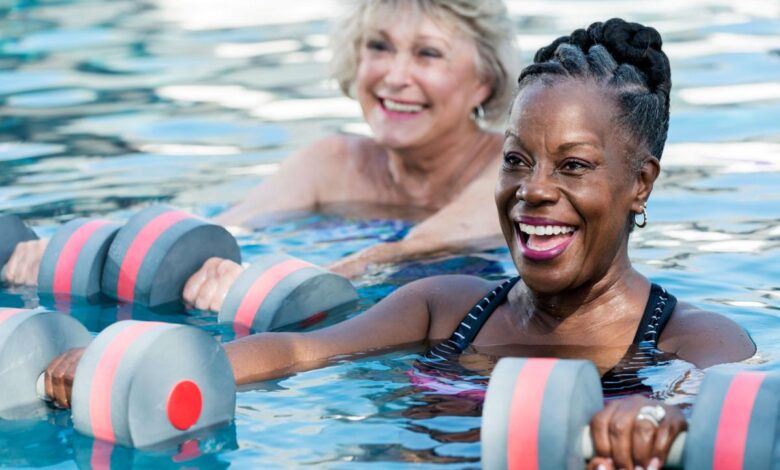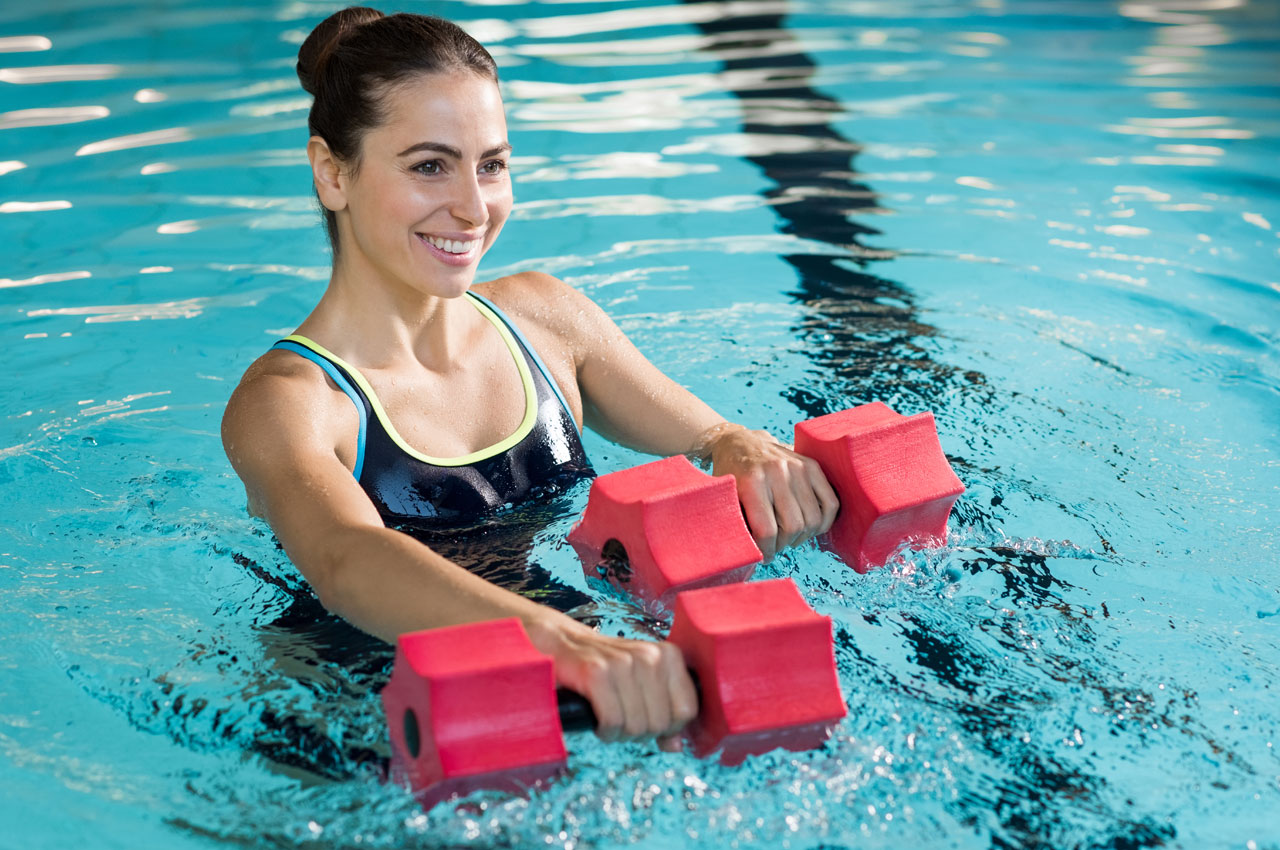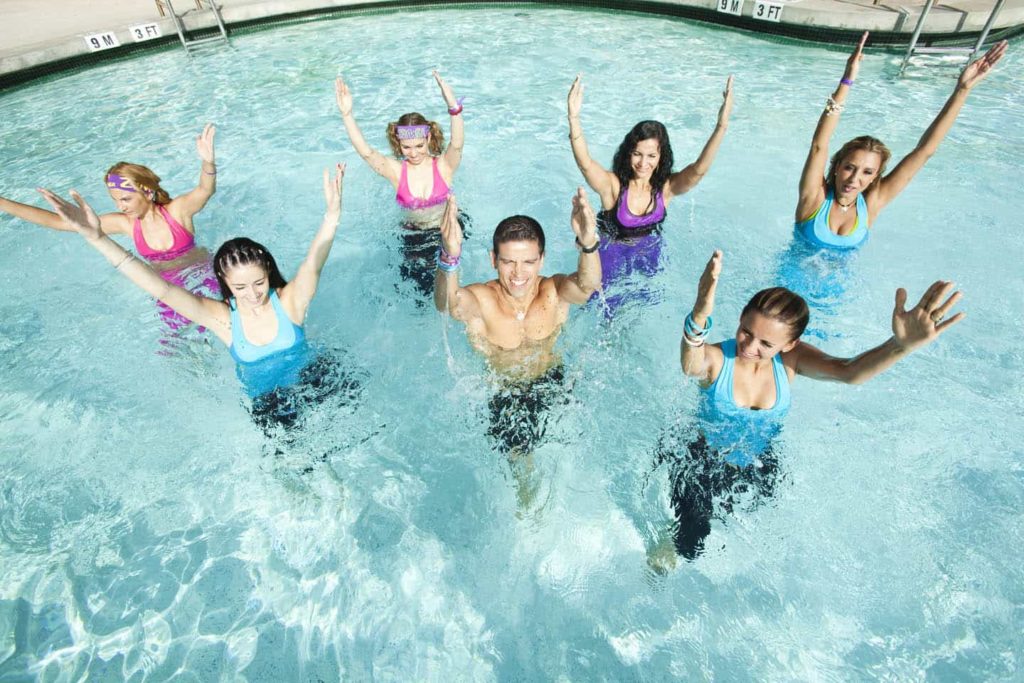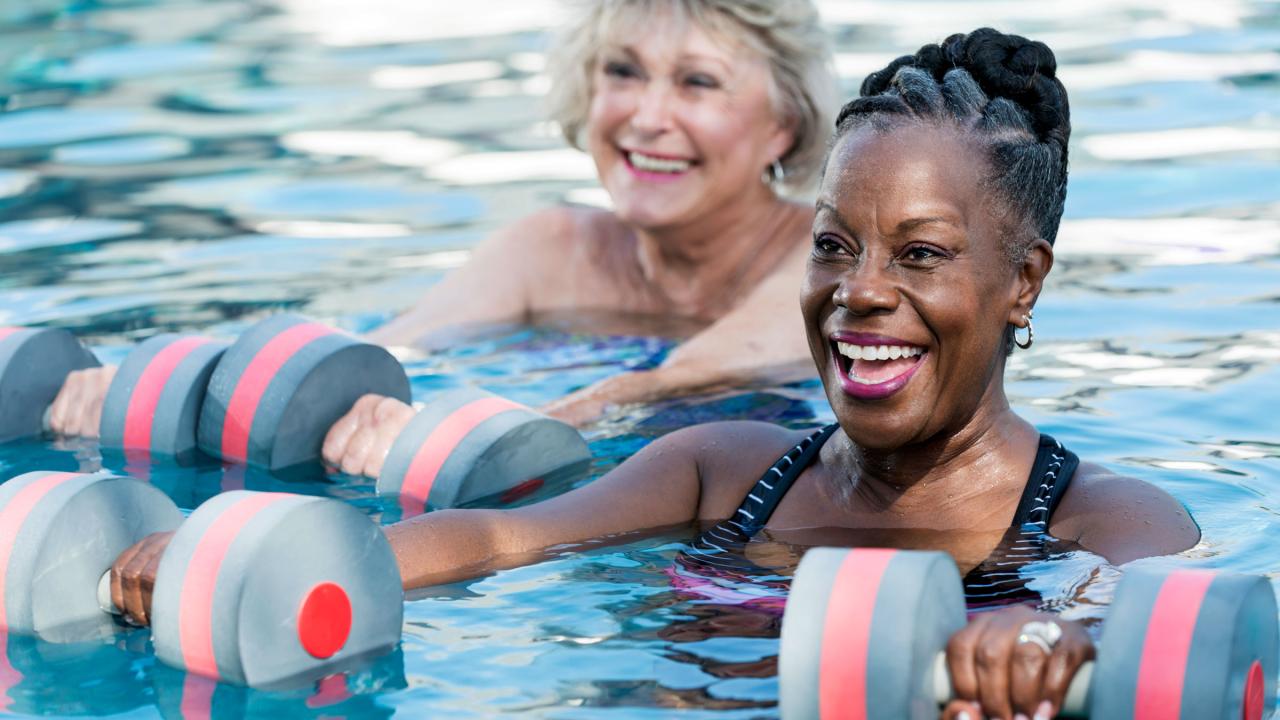
Simple Water Exercises for a Refreshing Workout
Simple exercises to do in the water can be a refreshing and effective way to get in shape. Whether you’re a seasoned athlete or just starting your fitness journey, water workouts offer a unique set of benefits that can enhance your overall health and well-being.
Water provides natural resistance, making every movement more challenging and engaging. The buoyancy of water also reduces stress on your joints, making it an ideal exercise option for people with arthritis or other joint conditions. Plus, water workouts are a great way to cool down and stay hydrated during hot weather.
Benefits of Water Exercises
Water exercises offer a unique and effective way to improve your fitness and overall well-being. They provide numerous advantages over traditional land-based workouts, making them a great option for individuals of all ages and fitness levels.
Reduced Stress on Joints and Muscles
Water’s buoyancy provides natural support, reducing the impact on your joints and muscles. This makes water exercises ideal for people with arthritis, osteoporosis, or other conditions that cause joint pain. The buoyant force of water supports your weight, lessening the strain on your joints during movement.
Cardiovascular Benefits of Water Exercises
Water exercises are an excellent way to improve your cardiovascular health. The resistance of water provides a challenging workout for your heart and lungs, helping to increase your heart rate and improve blood circulation.
Water Resistance Enhances Strength Training
Water resistance provides a unique challenge for your muscles, making water exercises an effective way to build strength and endurance. The resistance of water forces your muscles to work harder, leading to increased muscle mass and strength.
Warm-up Exercises

A proper warm-up is essential before any workout, especially in the water. It helps prepare your body for the activity, reduces the risk of injury, and enhances your performance. This warm-up routine combines gentle movements to increase your heart rate and flexibility.
Water Warm-up Routine
This routine consists of three exercises: arm circles, leg swings, and torso twists. Perform each exercise for 1-2 minutes, repeating each set 2-3 times.
Arm Circles
Arm circles help warm up your shoulders, improve flexibility, and increase blood flow to the arms.
- Stand in the water with your feet shoulder-width apart, holding onto the pool’s edge or a flotation device for support.
- Extend your arms out to your sides, palms facing down.
- Make small, controlled circles with your arms, gradually increasing the size of the circles.
- Reverse the direction of the circles, continuing to make small circles and gradually increasing the size.
Leg Swings
Leg swings help warm up your hips, hamstrings, and quadriceps.
- Stand in the water with your feet shoulder-width apart, holding onto the pool’s edge or a flotation device for support.
- Lift one leg slightly off the ground and swing it forward and backward in a controlled motion.
- Repeat with the other leg.
- Gradually increase the range of motion as you feel your muscles warm up.
Torso Twists
Torso twists help warm up your core muscles, improve flexibility, and increase blood flow to the abdomen.
Water workouts are a great way to get a full-body exercise without putting too much stress on your joints. You can try simple moves like walking, jogging, or even jumping jacks in the pool. And if you’re feeling adventurous, you can even try some light resistance training with water weights.
If you’re looking for an extra boost, you can also explore the potential benefits of cold showers, which some research suggests can offer a range of health benefits, such as improved circulation and mood. Do cold showers offer legit health benefits is a question that many people are asking, and the answer may surprise you.
No matter what type of water workout you choose, make sure to listen to your body and take breaks when needed.
- Stand in the water with your feet shoulder-width apart, holding onto the pool’s edge or a flotation device for support.
- Keep your legs slightly bent and your core engaged.
- Slowly twist your upper body to the right, keeping your hips stable.
- Return to the center and twist to the left.
- Repeat the twisting motion, gradually increasing the range of motion.
| Exercise | Description | Visual Representation |
|---|---|---|
| Arm Circles | Stand with feet shoulder-width apart, extend arms to sides, make small circles with arms, gradually increase size. | [Image of person standing in water, arms extended to sides, making small circles with arms.] |
| Leg Swings | Stand with feet shoulder-width apart, lift one leg, swing forward and backward, repeat with other leg. | [Image of person standing in water, lifting one leg and swinging it forward and backward.] |
| Torso Twists | Stand with feet shoulder-width apart, keep legs bent, twist upper body to right and left, keeping hips stable. | [Image of person standing in water, legs bent, twisting upper body to the right and left.] |
Cardiovascular Exercises

Water exercises are an excellent way to improve cardiovascular health, offering a low-impact, enjoyable, and effective workout. The buoyancy of water reduces stress on joints, making it suitable for people of all fitness levels.
Types of Cardiovascular Water Exercises
Here are some simple water exercises that can help improve your cardiovascular health:
- Water Walking: This involves walking in waist-deep water, using your arms for balance and propulsion. Water walking provides a gentle resistance, engaging your leg muscles and improving cardiovascular fitness.
- Water Jogging: Similar to water walking, water jogging involves running in place in deeper water, where the water provides resistance and support. Water jogging offers a more intense workout than water walking, challenging your cardiovascular system and leg muscles.
- Water Aerobics: This encompasses a variety of exercises performed in water, including jumping jacks, squats, lunges, and arm movements. Water aerobics provides a full-body workout, improving cardiovascular fitness, strength, and flexibility.
Intensity Levels
The intensity level of water exercises can be adjusted based on individual fitness levels and goals. Here’s a table outlining the intensity levels of different water exercises:
| Exercise Name | Description | Intensity Level |
|---|---|---|
| Water Walking | Walking in waist-deep water | Low to Moderate |
| Water Jogging | Running in place in deeper water | Moderate to High |
| Water Aerobics | Variety of exercises in water, including jumping jacks, squats, and lunges | Low to High |
Strength Training Exercises
Water-based strength training exercises provide an excellent way to challenge your muscles while enjoying the buoyancy and resistance of water. The water’s resistance acts as a natural weight, making each movement more challenging and engaging more muscle fibers. This type of training is suitable for all fitness levels, as you can easily adjust the intensity by changing the depth of the water, your movement speed, and the amount of resistance you apply.
Water Squats
Water squats are a great exercise for strengthening your lower body, including your quadriceps, hamstrings, and glutes.
After a refreshing swim, nothing beats a warm, comforting meal. I love making a batch of slow cooker vegan mashed sweet potatoes to enjoy after a water workout. They’re so easy to prepare, and the slow cooker does all the work.
Plus, they’re packed with nutrients and perfect for fueling up after a good water aerobics session.
- Stand with your feet shoulder-width apart, facing the shallow end of the pool.
- Slowly lower your body as if you were sitting down on a chair, keeping your back straight and core engaged.
- Push through your heels to return to the starting position.
To increase the intensity, you can try holding a water weight or doing the exercise in deeper water.
Water workouts are a great way to get a full-body exercise without putting too much stress on your joints. You can do simple things like walking, jogging, or even jumping jacks in the pool. But if you’re looking for something more challenging, try adding in some resistance bands or weights.
It’s worth noting that standing for long periods might not burn enough calories to significantly aid weight loss, as explained in this article: does standing burn enough calories to aid weight loss. However, water workouts can be a great way to build strength and endurance, which can contribute to overall fitness and weight management.
Water Lunges
Water lunges are another excellent exercise for targeting your lower body, especially your quadriceps, hamstrings, and glutes.
- Stand with your feet shoulder-width apart, facing the shallow end of the pool.
- Take a large step forward with one leg, bending your knee until your front knee is aligned with your toes and your back knee is close to the ground.
- Push through your front heel to return to the starting position.
- Repeat on the other side.
To increase the intensity, you can try holding a water weight or doing the exercise in deeper water.
Water Push-Ups
Water push-ups are a challenging exercise that works your chest, shoulders, and triceps.
- Stand facing the pool wall, with your hands shoulder-width apart and your fingers pointing forward.
- Lean forward and place your hands on the wall, keeping your body straight and core engaged.
- Bend your elbows and lower your chest towards the wall, until your chest almost touches the wall.
- Push back up to the starting position.
To increase the intensity, you can try doing the exercise in deeper water or holding a water weight.
Cool-down Exercises
Cooling down after your water workout is just as important as warming up. It helps your body gradually transition back to a resting state, preventing muscle soreness and stiffness.
Stretching in the Water
Gentle stretching in the water can help improve flexibility and range of motion. The buoyancy of the water supports your body, making it easier to perform stretches without putting too much strain on your joints. Here are some examples of stretches you can do in the water:
- Arm Circles:Stand with your feet shoulder-width apart and arms extended to the sides. Slowly rotate your arms in a circular motion, first forward and then backward. Repeat 10-15 times in each direction.
- Leg Swings:Stand with your feet shoulder-width apart and hold onto the side of the pool. Slowly swing one leg forward and backward, keeping your leg straight. Repeat 10-15 times on each leg.
- Back Stretches:Stand with your feet shoulder-width apart and reach your arms overhead. Slowly bend to the side, reaching your hand toward your opposite foot. Hold for 10-15 seconds and repeat on the other side.
Relaxation Techniques
After stretching, it’s important to relax your muscles and allow your heart rate to return to normal. You can do this by simply floating on your back in the water, allowing the water to support your body. You can also try some deep breathing exercises, inhaling slowly and deeply and exhaling slowly and completely.
Safety Considerations: Simple Exercises To Do In The Water

Water exercises offer numerous health benefits, but safety should always be a top priority. Taking precautions can help you enjoy your workouts while minimizing the risk of injury.
Choosing the Right Depth
The depth of the water is crucial for safety and effectiveness during water exercises. The depth should be appropriate for your height and the exercises you plan to do.
- Shallow Water:Ideal for exercises like walking, jogging, and water aerobics, where you can maintain contact with the bottom.
- Deep Water:Suitable for activities like swimming, water running, and flotation exercises, where you can move freely without touching the bottom.
Importance of Proper Hydration and Rest
Staying hydrated is essential for any physical activity, especially in water, where you can lose fluids through sweating and evaporation.
- Hydration:Drink plenty of water before, during, and after your workout to prevent dehydration.
- Rest:Give your body adequate rest between workouts to allow for recovery and prevent overexertion.
Recognizing and Responding to Discomfort or Injury
Listen to your body and be aware of any signs of discomfort or injury during your water exercises.
- Pain:Stop the exercise immediately if you experience any sharp or persistent pain.
- Dizziness:If you feel dizzy or lightheaded, get out of the water and rest.
- Muscle Cramps:Stop the exercise and gently stretch the affected muscle.
Variations and Modifications
Water exercises can be adapted to suit different fitness levels and individual needs. By adjusting the intensity, duration, and type of exercises, you can create a safe and effective workout that meets your goals.
Exercises for Different Fitness Levels
Water exercises can be modified to accommodate individuals with varying fitness levels.
- Beginners: Beginners should start with simple exercises like walking in the water, arm circles, and leg lifts. These exercises help build strength and endurance gradually.
- Intermediate: Intermediate exercisers can incorporate more challenging movements like water jogging, water aerobics routines, and resistance exercises using water weights or flotation devices.
- Advanced: Advanced exercisers can perform high-intensity exercises like water running, swimming laps, and advanced water aerobics routines. These exercises provide a significant cardiovascular workout and build strength and endurance.
Adjusting Intensity and Duration
The intensity and duration of water exercises can be adjusted based on personal capabilities.
- Intensity: Intensity can be increased by moving faster, adding resistance, or performing more repetitions. For example, walking in the water can be made more challenging by increasing the speed or adding a flotation belt for resistance.
- Duration: The duration of exercises can be adjusted based on fitness level and goals. Beginners can start with shorter sessions and gradually increase the duration as they get stronger.
Modifying Exercises for Specific Needs
Water exercises can be modified to accommodate specific needs or limitations.
- Joint pain: For individuals with joint pain, exercises should be performed with a focus on range of motion and flexibility. Low-impact exercises like water walking and arm circles can be beneficial.
- Balance issues: Individuals with balance issues can use flotation devices for support during exercises. Exercises should be performed slowly and carefully, with a focus on stability.
- Limited mobility: For individuals with limited mobility, exercises can be modified to focus on specific muscle groups. For example, arm exercises can be performed while seated on a pool bench.
Examples of Modified Exercises, Simple exercises to do in the water
Here are some examples of modified exercises for different fitness levels and needs:
- Water walking: This is a great exercise for beginners and individuals with joint pain. It can be made more challenging by increasing the speed or adding a flotation belt for resistance.
- Arm circles: Arm circles are a good exercise for improving shoulder mobility and strength. They can be performed in both forward and backward directions.
- Leg lifts: Leg lifts help strengthen the leg muscles and improve balance. They can be performed with or without a flotation device.
- Water jogging: Water jogging is a great cardiovascular workout that is low-impact on the joints. It can be made more challenging by increasing the speed or adding a flotation belt for resistance.
- Water aerobics: Water aerobics routines are a fun and effective way to improve cardiovascular fitness and strength. They can be modified to accommodate different fitness levels.
- Resistance exercises: Resistance exercises can be performed using water weights or flotation devices. These exercises help build strength and endurance.
Conclusive Thoughts
So, dive in and experience the transformative power of water exercises! From invigorating cardio to strength-building routines, there’s a water workout for everyone. Remember to listen to your body, stay hydrated, and enjoy the refreshing experience of exercising in the water.

